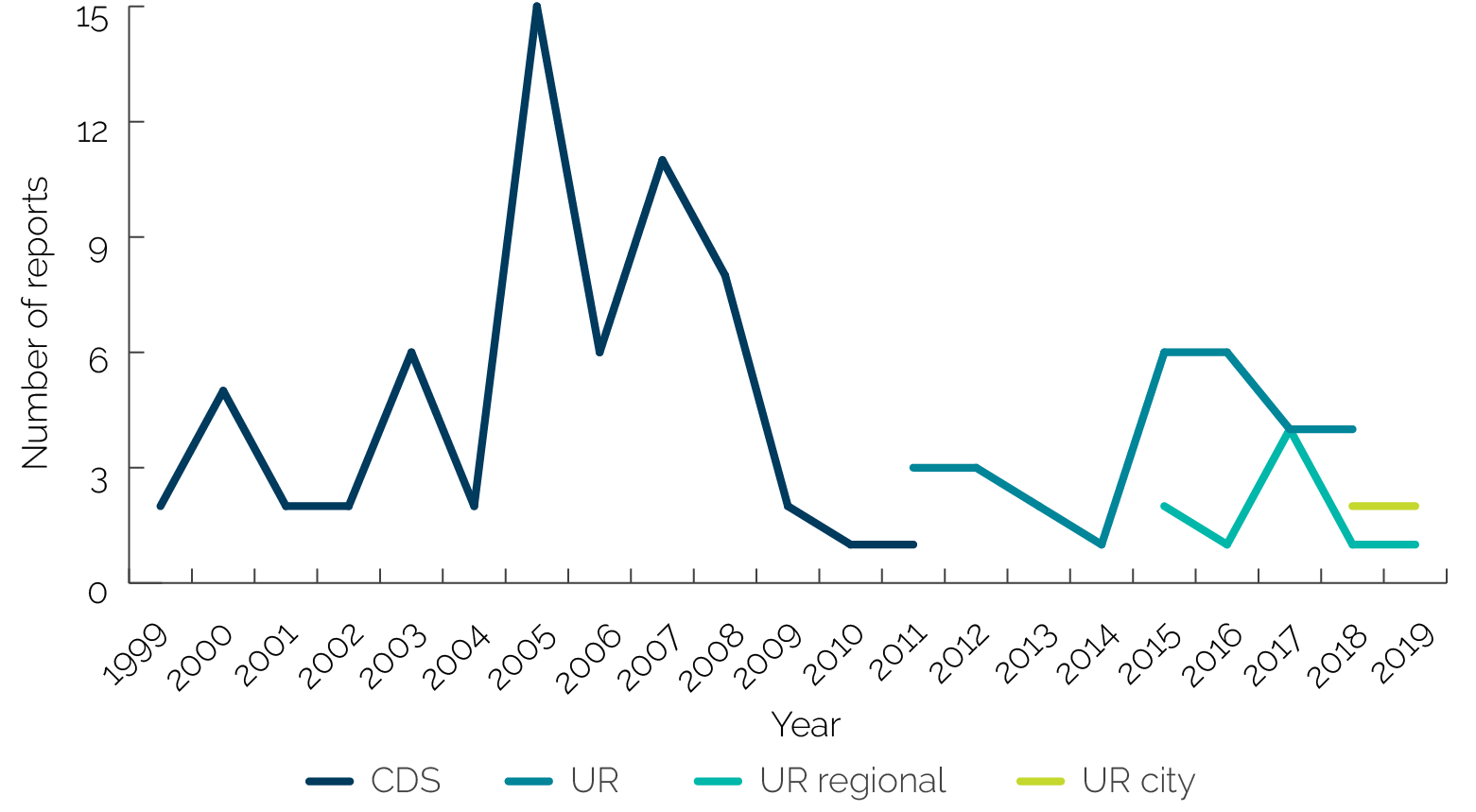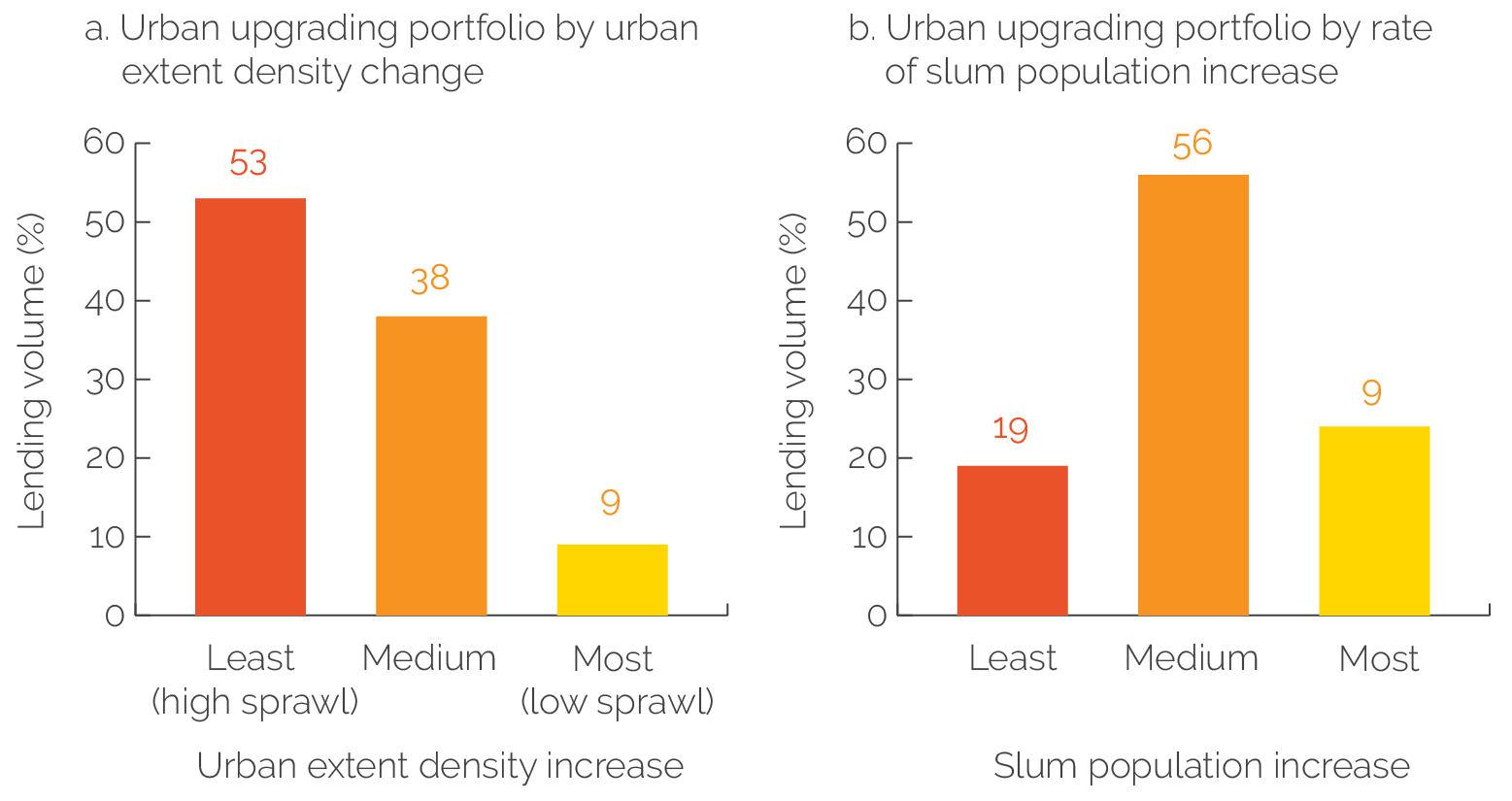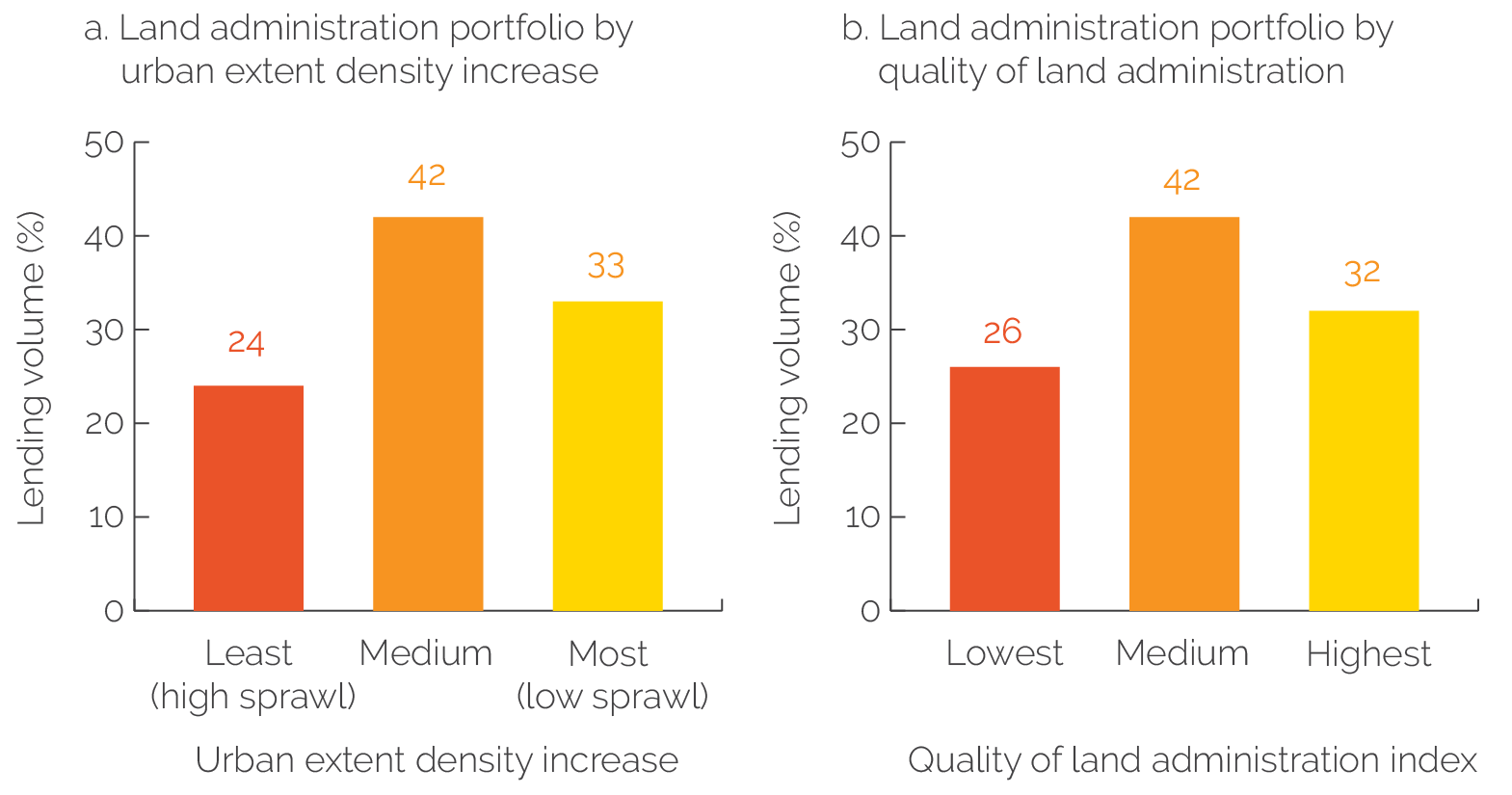Managing Urban Spatial Growth
Chapter 2 | The Relevance of World Bank Support for Managing Urban Spatial Growth
Highlights
World Bank corporate (global) urban strategies have increasingly recognized the need to focus on managing urban spatial growth, but the corporate strategies and framework are not fully consistent with the New Urban Agenda and the Sustainable Development Goals.
The World Bank has taken on important global roles, including contributions to the Integrated Geospatial Information Framework, Sustainable Development Goal indicator 1.4.2 on secure rights to land, and the Doing Business indicators related to the quality of land administration.
World Bank country strategies that address urban development have been increasingly recognizing the importance of the determinants of urban spatial growth. However, they rarely address the overarching issue of managing urban spatial growth.
World Bank technical assistance through Urbanization Reviews addresses urban spatial growth and has informed national land management and land-use planning policies in client countries.
World Bank lending support does not consistently go to countries where cities are rapidly sprawling and slum populations are growing.
The World Bank has focused on curative and, to a lesser extent, on preventive approaches and on tools that are essential for managing urban spatial growth.
This chapter examines how relevant World Bank work is to increasing clients’ capacity to manage urban spatial growth. It does so by assessing the World Bank’s focus on urban spatial growth at the global level and at the country and city levels.
World Bank Focus on Urban Spatial Growth at the Global Level
The World Bank has been addressing the management of urban spatial growth at the corporate (global) level but is not yet fully aligned with the global agenda. Over the past 29 years, the World Bank has been increasingly relevant through its global urban strategies and its role in specific global strategic initiatives: creating the Integrated Geospatial Information Framework and shaping the Doing Business indicator on the quality of land administration, which is related to urban expansion. However, the World Bank has not yet wholly fulfilled its role in the custodianship of an SDG indicator that measures land ownership (SDG 1.4.2). In addition, the World Bank’s most recent global strategy, Systems of Cities, and framework, Planning, Connecting, and Financing Cities, do not fully align with relevant SDGs and the New Urban Agenda, a UN road map for building prosperous cities that serve human well-being and protect the environment (UN 2017a; World Bank 2009, 2013b).
World Bank Global Urban Strategies
World Bank corporate urban strategies have increasingly recognized the need to focus on managing urban expansion and land use. Since the 1990s, the World Bank has produced three flagship urban strategies. The Agenda for the 1990s emphasized the links between urban economic activities and macroeconomic performance and productivity (World Bank 1991). The 1991 strategy also recognized that deficient land use and building regulations increase the costs of urban development and foster the creation of slums. The 2000 strategy Cities in Transition highlighted the effects of urban transformation and flawed real estate policies on land use and housing investments, with major ramifications for households, businesses, and nations (World Bank 2000). The World Bank issued its current strategy, Systems of Cities, in 2009. It further emphasized the importance of helping cities update their urban planning regulations so that they can manage higher population densities and prevent demand for scarce housing and land from bidding up prices excessively. Over time, the World Bank strategies increased their focus on issues related to land administration, land-use planning, and land development as fundamental building blocks for managing urban expansion (table 2.1).
Table 2.1. Evolution of Themes Covered by World Bank Urban Strategies
|
1991 |
2000 |
2009 |
|
Productivity of urban economies Participation of urban poor people in labor markets Access to services Urban environment Urban action research |
Livability through land administration and land development (for example, housing and services for poor people) Competitiveness through broad-based growth of urban employment and investment Good governance through accountability, capacity, integrity, and transparency Bankability through city creditworthiness |
Managing urban density and agglomerations to foster economic productivity and social equity Land administration and housing City planning Land development through slum upgrading and urban transport Urban poverty Climate change and environmental management |
Source: Extracted from World Bank 1991, 2000, and 2009.
In 2013, the World Bank developed a framework that establishes a clear sequence of actions to achieve sustainable urban development. Planning, connecting, and financing are at the heart of the framework (World Bank 2013b), which complements earlier strategies and reflects the sequencing of actions to build sustainable cities. Planning refers to charting a course for cities by setting the terms of urbanization, especially policies for using urban land and expanding basic infrastructure and public services. Connecting refers to making a city’s markets (labor, goods, and services) accessible to the whole city, other cities, and export markets. Financing refers to finding sources for large capital outlays needed to provide infrastructure and services as cities grow and urbanization accelerates. For the framework to work, a good governance structure is a prerequisite. In regard to sequencing, planning for land use and basic services is primary. Yet, because planning must allow for people and products to be mobile, it must be coordinated with connecting at all stages of a city’s growth. What follows then is financing, a dimension that, although as necessary as the other two, should be city leaders’ last concern rather than their first.
The World Bank has also developed a housing framework and relevant global and regional analytical work on urban spatial growth, but its corporate urban strategy does not fully reflect in an integrated manner current international consensus on the management of urban spatial growth. The housing framework (World Bank 2020d) was established recently and reflects the global consensus on sustainable urban development, setting forth that the joint housing sector work of the International Finance Corporation and the World Bank focuses on improving housing supply and demand by promoting policies to improve the enabling environment for the supply of housing and housing finance, improving access to land and basic infrastructure, promoting better urban and city planning, financing and building the capacity of developers, supporting low-cost and resilient construction, implementing affordable housing finance instruments, leveraging capital markets, and improving residential rental markets in emerging markets. The World Bank has also provided leadership over the past five years on issues such as land regeneration, transit-oriented development, geospatial information, and the management of public spaces.1 However, the current strategy (World Bank 2009) and subsequent work on urban expansion have not yet been integrated into a framework to fully reflect international consensus, including concepts such as public space, geospatial information, capturing land value, and urban resilience, which are central to managing urban spatial growth and are included in SDG 1 (End poverty in all its forms everywhere), SDG 11 (Make cities and human settlements inclusive, safe, resilient, and sustainable), the New Urban Agenda, and the International Guidelines for Urban and Territorial Planning (box 2.1). Furthermore, the World Bank strategy does not mention concepts related to ensuring inclusive land-use planning such as gender, disability, and age.
Box 2.1. The New Urban Agenda and the International Guidelines for Urban and Territorial Planning
The United Nations’ New Urban Agenda lays out standards and principles for the planning, construction, development, management, and improvement of urban areas. It recognizes five main pillars of implementation: national urban policies, urban legislation and regulations, urban planning and design, local economy and municipal finance, and local implementation. It is a resource for every level of government, from national to local; for civil society organizations; for the private sector; and for constituent groups. The New Urban Agenda recognizes the correlation between good urbanization and development. It emphasizes the links between good urbanization and job creation, livelihood opportunities, and improved quality of life, which should be included in urban renewal policies and strategies. The New Urban Agenda is closely linked to the 2030 Agenda for Sustainable Development, especially goal 11 on sustainable cities and communities.
The International Guidelines on Urban and Territorial Planning provide a framework for improving global policies, plans, designs, and implementation processes. The aim of the framework is to develop more compact, more socially inclusive, better integrated and connected cities and territories that foster sustainable urban development. The guidelines seek to (i) develop a universally applicable reference framework to guide urban policy reforms; (ii) capture universal principles from national and local experience that could support the development of diverse planning approaches adapted to different contexts and scales; and (iii) raise the profile of urban and territorial planning in the development agendas of national, regional, and local governments.
Sources: UN 2017a; UN-Habitat 2016.
Integrated Geospatial Information Framework
In coordination with the UN, the World Bank has developed an Integrated Geospatial Information Framework. This is a guide for developing, integrating, and strengthening geospatial information management and related resources in all countries. It is a fundamental building block to enable managing urban expansion because it allows countries to develop their national and subnational spatial data infrastructure, which comprises policies, institutional arrangements, technologies, remote sensing data, and people that together enable the sharing and effective use of geographic information by standardizing formats and protocols for access and interoperability. Effective spatial data infrastructure enables cities to use geospatial data to efficiently measure and monitor spatial urban expansion and social, economic, and environmental development. The World Bank’s role in this effort is significant in that geospatial information related to urban growth is a major part of the underpinning data infrastructure to enable land administration, planning, and development. The rollout process of the framework has so far resulted in 4 of 20 country-level action plans scheduled to be delivered in FY20 to operationalize the framework.
Sustainable Development Goal Custodianship
The World Bank—through the Development Economics Vice Presidency—is a custodian of SDG indicator 1.4.2, “proportion of total adult population with secure tenure rights to land.” In 2015, the UN assigned international agencies as custodians to monitor SDG targets. The World Bank and UN-Habitat are the joint custodians of SDG indicator 1.4.2 (UN 2020). The Food and Agriculture Organization is the custodian of SDG indicator 5.a.1 (women’s ownership of agricultural land), which is closely related. These three institutions are collaborating to develop a standardized survey instrument to collect the essential data for computing both indicators simultaneously.
The World Bank has started to fulfill its SDG custodian function and was able to report on SDG indicator 1.4.2 in October 2020. Custodians should report annually to the UN. Data collection challenges have been a barrier because land registry and cadastre data are collected through land agencies whose systems are not integrated, centralized, or well maintained. In addition, there have been delays in developing the survey methodology to enable the collection of data.
Doing Business Indicators on the Quality of Land Administration
The World Bank, through the Development Economics Vice Presidency, has defined the Doing Business indicators related to the quality of land administration. The Land Governance Assessment Framework, which has rolled out in 39 countries, primarily in Africa, is a World Bank flagship land administration diagnostic instrument that assesses the state of national and subnational land administration. In 2015, the Land Governance Assessment Framework and Doing Business survey teams collaborated to enhance the Doing Business registering property indicator, which measures the steps, time, and cost involved in registering a property, assuming a standardized case of an entrepreneur who wants to purchase land and a building that is already registered and free of title dispute. In 2015, the indicator was broadened to measure the quality of the land administration. The quality of land administration index has five dimensions: reliability of infrastructure, transparency of information, geographic coverage, land dispute resolution, and equal access to property rights. For the first time, the Doing Business survey could track the efficiency of urban land use. For example, between 2016 and 2020, out of 133 countries, 57 showed improvements in the quality of land administration.
“The Right Things in the Right Places”: World Bank Focus on Urban Spatial Growth at the Country and City Levels
Country Strategies
World Bank country strategies that address urban development have been increasingly recognizing the importance of land administration, land-use planning, and land development through urban transport and urban upgrading in fast-urbanizing countries. Content analysis of country strategies in 19 countries that address urban development shows increasing emphasis on key determinants of managing urban spatial growth (figure 2.1). The growing focus on urban spatial growth is particularly clear in fast-urbanizing countries, where mentions of land-use planning increased from 30 percent of country strategies in 2005 to about 50 percent in 2015, and mentions of urban upgrading increased from 10 percent of country strategies in 2005 to 38 percent in 2015. For example, since 2000, Mozambique’s Country Assistance Strategies and Country Partnership Frameworks have identified land administration as a key issue for urban development. Strategies in Mozambique evolved from just focusing on land administration to include land-use planning and, more recently, second-generation reforms that integrate land administration and management systems, territorial planning, and land markets. Ghana’s 2000 and 2004 Country Assistance Strategies focused on land administration under a growth and employment pillar in the context of removing constraints on private sector development by improving access to and security of land. The subsequent strategies show an increased recognition of and commitment to land-use planning and urban transport systems.
Figure 2.1. Country Strategies Capturing Core Elements of Managing Urban Spatial Growth over Time, for Fast- and Moderate-Urbanizing Countries
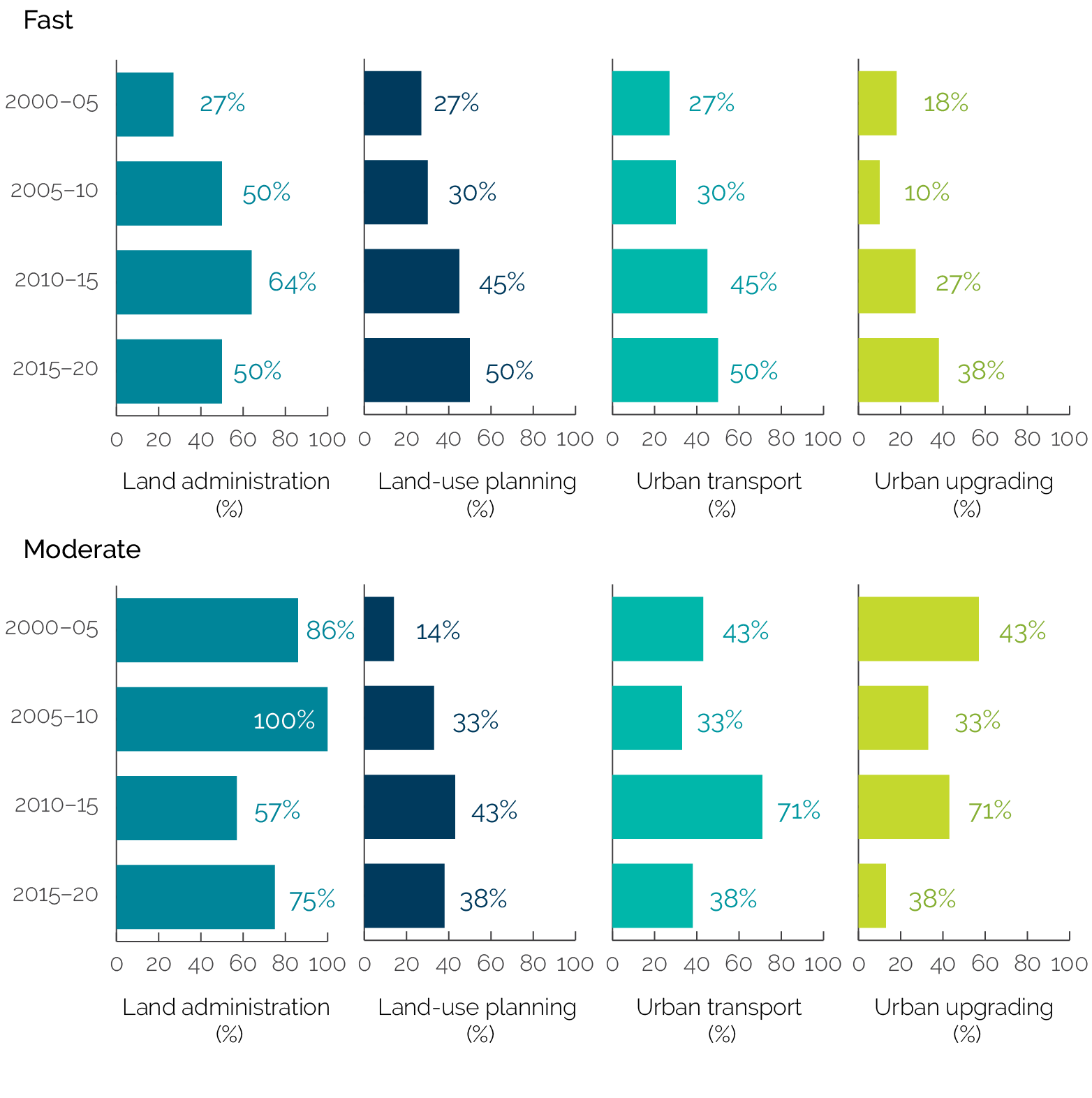
Source: Independent Evaluation Group.
However, most country strategies that address urban development do not address the pervasive issue of urban spatial growth. It is one thing to address land administration, land-use planning, or land development in isolation. It is another thing to do so as part of an explicit strategy of managing urban growth. IEG analysis shows that only 3 of 11 country strategies in fast-urbanizing countries that address urban development explicitly address managing urban spatial growth (Bhutan, India, and Vietnam; box 2.2). In the other 8 country strategies, land administration, land-use planning, or land development are part of strategic pillars, but they are not articulated as part of a strategic objective of managing urban spatial growth. This is partially explained by an emphasis on short- rather than long-term and integrated planning by clients, which in turn affects the nature of demand for World Bank support. For example, the Kosovo FY12–15 Country Partnership Framework mentioned land administration but did not include references to the overall management of urban spatial growth, given the high physical expansion of urban areas and urban population growth as a result of migration and the proliferation of informal growth.2 Kosovo is a conflict-affected country with limited institutional capacity and short-term needs (such as reconstruction, social cohesion, and job creation) that are more urgent than addressing urban spatial growth. The 1997 and 2008 Ghana Country Assistance Strategies acknowledged the need to establish coordinated sectoral investment in urban areas. This is relevant because the 2005 World Bank report The Dynamics of Global Urban Expansion highlighted Accra as a prominent global example of the need to get ahead of urban sprawl by planning infrastructure services ahead of the physical expansion of the city (Angel, Sheppard, and Civco 2005). It is noteworthy that the subsequent 2013 Country Partnership Strategy does not mention urban sprawl as the underlying challenge in the inability of the government of Ghana to meet the growing demands for infrastructure and services for poor people.
Box 2.2. World Bank Country Strategies Specifically Aimed at Managing Urban Expansion
The 2003–06 Vietnam Country Assistance Strategy (CAS) noted the country’s rapid urbanization, mainly due to rural-urban migration, and recognized that Vietnam lacked a clear human settlement policy to accommodate the 11 million urban inhabitants expected to arrive within a decade. The program laid out in the CAS aimed to help with government planning for the coming urban expansion. Since then, the World Bank has been supporting Vietnam in successfully improving tenure security throughout the country. Subsequent country strategies have stressed the need to address areas of rapid urbanization through strengthening the transparency of Vietnam’s system for land administration while aiming at stepping up support related to land-use planning and the development of more efficient land markets.
The 2006–09 Bhutan CAS aimed to support Bhutan with growth-oriented investments in urban infrastructure. The goal was to allow for urban expansion without negative effects such as overcrowding and a proliferation of areas that lack infrastructure and services, such as slums. Under the first pillar of the CAS, the World Bank Group aimed to help the government of Bhutan prepare a National Urban Strategy and a City Development Strategy for Thimphu. These strategies were successfully completed and have helped guide the management of urban growth efficiently and equitably.
The subsequent 2011–14 Bhutan Country Partnership Strategy emphasized the need to address shifting demographics. An increasing proportion of the population lived in urban areas that lacked sufficient infrastructure, including water, sewerage, and transportation facilities. This Country Partnership Strategy also aimed to support the provision of urban infrastructure and to build capacity for municipal authorities to better plan, manage finances, and deliver services.
The 2013–17 India Country Partnership Strategy recognized an acceleration of India’s ongoing transformation from a predominantly rural to an increasingly urban population. The Bank Group aimed to focus on urbanization in second-tier cities and in larger metropolises, representing a shift from the first-tier focus of past strategies. The multisectoral engagement was centered on urban management and planning, infrastructure and service delivery, financing systems and frameworks, and capacity building at the national, state, and city levels. Analytical work to inform urban sector policy and initiatives aimed to supplement a growing operational engagement.
Sources: World Bank 2002, 2005a, 2010, 2014.
Technical Assistance
The Urbanization Review is one mechanism by which the World Bank engages with governments on urban spatial growth at the city and country level. Urbanization Reviews, as the name implies, focus on urbanization. They sometimes cover a single city, sometimes a subnational region, and most often an entire nation. Like City Development Strategies (CDSs), they are products of technical assistance, and they are often intended to help clients enhance urban development policies or strategies.
From 1999 to 2011, the World Bank supported the preparation of CDSs and technical assistance through the Cities Alliance. The Cities Alliance was created in 1999 as a multidonor trust fund resulting from a World Bank/UN-Habitat agreement to support the Livable Cities agenda of the UN Human Settlements Conference in Istanbul. The main objective of the alliance is to enhance urban development cooperation. It provides technical assistance to support slum upgrading and the preparation of CDSs. The World Bank adopted the principles of enhancing urban development through CDSs and slum upgrading in its 2000 urban strategy (World Bank 2000).
The technical assistance support through CDSs enabled World Bank engagement at the city level. Operating in all regions of the world through a partnership of international players gave the Cities Alliance the reach needed to disseminate its experience with CDSs and slum upgrading as global knowledge products. From the alliance’s inception until 2011, the World Bank was its second-largest contributor, contributing 16 percent of the alliance’s funds (Cities Alliance 2012). Support to Cities Alliance enabled the World Bank to deepen its engagement on managing urban spatial growth at a subnational level.
Following the recommendations of the 2009 World Bank urban strategy, the World Bank largely shifted its policy dialogue from cities to national governments and is heavily focused in countries with medium to high urban sprawl. The 2009 World Bank urban strategy recognized the critical role of national governments in establishing urban policies. After 2011, the World Bank largely shifted technical assistance to national governments from CDSs to the newly established Urbanization Reviews. Since 2015, Urbanization Reviews have also addressed regional urban development and, more recently, emphasized capital cities (figure 2.2). About 83 percent of Urbanization Reviews are focused in countries that are experiencing medium to high sprawl.
Figure 2.2. World Bank Flagship Technical Assistance for Urbanization Evolution
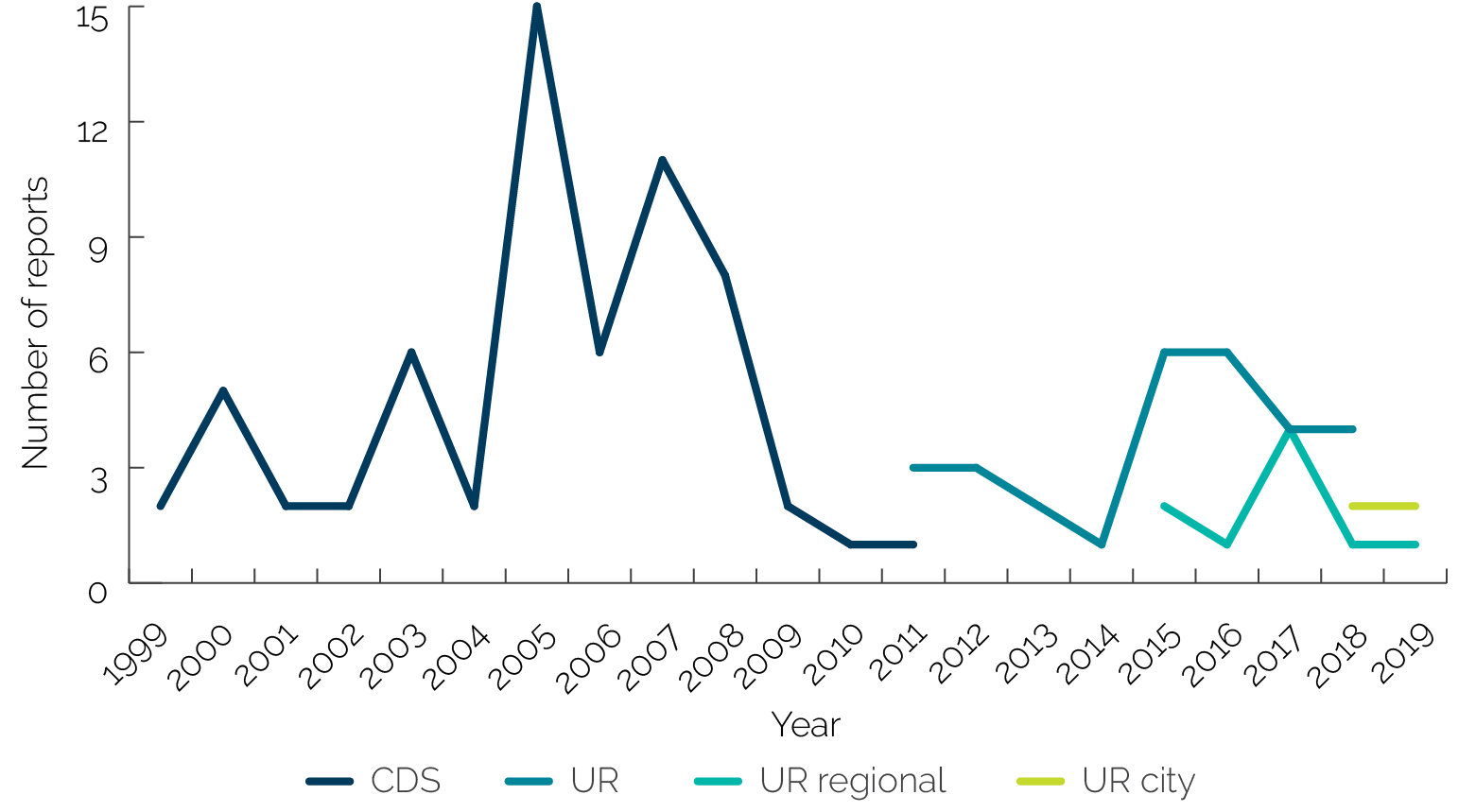
Source: Independent Evaluation Group.
Note: CDS = City Development Strategy; UR = Urbanization Review.
Technical assistance through Urbanization Reviews has informed national land management and land-use planning policies in client countries. According to the 2016 independent evaluation of the Multi-Donor Trust Fund for Sustainable Urban Development (Vaggione 2016), World Bank advisory services and analytics have influenced key urban policies such as China’s National New-Type Urbanization Plan (2014–2020) and state-level urban development programs in India. An IEG survey revealed that 87 percent of World Bank staff consider Urbanization Reviews to have contributed to national urban policies, 68 percent consider them to have contributed to city-level strategies, and 74 percent consider them to have contributed to clients’ capacity to manage urban spatial growth. When asked to recall instances of Urbanization Review use by government counterparts and other stakeholders, respondents cited examples in Serbia, where the regional Urbanization Review supports a new spatial development plan, and in Vietnam, where the Urbanization Review was used as a basis for establishing the National Urban Forum. The Urbanization Reviews have also been effective in leveraging World Bank investment (box 2.3).
Box 2.3. Leveraging World Bank Investments through Urbanization Reviews
From 2011 to 2016, every dollar allocated to Urbanization Reviews contributed to leveraging $409 in lending projects. The World Bank has indicated that lending projects for $2.9 billion can be linked to a certain extent to Urbanization Reviews. In Colombia, the Urbanization Review has contributed to shaping two downstream development program–lending operations with a combined value of $850 million. In Vietnam, the Urbanization Review has also enabled strong subnational engagement, building on the “plan, connect, finance” principles, as in the Ho Chi Minh City development strategy and several lending operations, including the $200 million Ho Chi Minh City Green Transport Development.
Source: Vaggione 2016.
Two field case studies show the positive contributions of Urbanization Reviews to clients’ national urban policies. Colombia’s 2015 National Urban Policy was influenced by the findings of the World Bank’s Urbanization Review (Samad, Lozano-Gracia, and Panman 2012), and the Department of National Planning is using the findings of the Urbanization Review to define Misión Ciudades, a high-level committee to strengthen the system of cities toward 2035. In 2014, the government of India decided to expand and redesign its program for city development. The World Bank president and India’s prime minister agreed that the World Bank would provide support to manage urban spatial growth by contributing to the conceptual framework of a government program to help 500 cities upgrade or install new infrastructure and by designing a program to create 100 smart cities. The World Bank produced a note that contributed to the Atal Mission for Rejuvenating Urban Transformation Program in India with the aim of providing urban infrastructure such as water supply, sewerage, urban transport, and parks to improve the quality of life for all, especially poor and disadvantaged people. India’s 12th five-year plan and overall national urban proposal largely reflect the diagnostics of the World Bank’s Urbanization Review and a two-year high-level dialogue with the Ministry of Urban Development and the Planning Commission.
Two field case studies show alignment with city strategies. Although the intensity of support varies by stage of urbanization, support at the national and city levels in eight case study countries was congruent with national and local development plans. Support to Can Tho, Vietnam, one of the fastest-growing cities in the world, included the development of a strategic plan that guided investments in managing urban growth and resilience. Subsequently, the World Bank supported the city with a series of investments in urban upgrading, including the creation of resettlement zones, urban transport, and resilience. In Maputo, Mozambique, World Bank support at the municipal level has translated into a sequence of operations in line with the 10-year municipal development program (2001–17) and the subsequent 5-year city plan that defines the governance principles and the city priorities, including the management of urban land, rehabilitation and creation of infrastructure, and transportation. However, there has not been a specific urban strategy covering these aspects for greater Maputo, where urban expansion is taking place.
Lending Portfolio
At the operational level, World Bank technical assistance through Urbanization Reviews addresses the issue of urban spatial growth, but the lending portfolio addresses it to a much lesser extent. About 90 percent of Urbanization Reviews highlight the need to manage urban spatial growth, but only 44 percent of relevant Project Appraisal Documents (PADs) in countries with Urbanization Reviews include managing urban spatial growth as an issue in the Strategic Context section, and only 4 percent of these PADs allocate funds to manage urban spatial growth. However, over time there has been an increased emphasis on highlighting the need to manage urban spatial growth in projects—it was mentioned in the Strategic Context section of 24 percent of PADs in FY01–09 versus 50 percent of PADs in FY10–18. In addition, the World Bank supported clients through stand-alone technical assistance addressing issues related to the management of urban spatial growth identified in the Urbanization Reviews. For example, in Vietnam, World Bank technical assistance supported a participatory planning process that contributed to defining the land use of the Ho Chi Minh bus rapid transit (BRT) corridor.
To What Extent Is the World Bank Working in Places That Require Support in Managing Urban Spatial Growth?
In aggregate, World Bank support is not fully addressing the growth in slum populations in countries with the highest needs. Overall, about 50 percent of urban upgrading lending volume goes to countries that require support in managing urban spatial growth, as measured by low-density development, an indicator of urban sprawl (figure 2.3, panel a). By contrast, only about 24 percent of lending volume goes to countries where slum populations are growing the most (figure 2.3, panel b). Notable cases of World Bank support with high levels of population increases within the evaluation portfolio include Ghana, Kenya, and Mozambique. In 2001, the slum population of Ghana was estimated at approximately 4.5 million people, growing at a rate of 1.83 percent per year and scattered across the country’s major cities. This population reached 4.9 million by 2010 and 5.3 million in 2014. In Kenya, the number of people living in slums increased from approximately 1.5 million in 1990 to 6.4 million in 2014.
Limited support has gone to countries that lack the foundations of land administration, but support to these countries is growing. About 75 percent of the land administration portfolio focuses on countries with medium to low sprawl (figure 2.4, panel a). About 42 and 32 percent of lending volume is concentrated in countries with medium- and high-quality land administration, respectively (figure 2.4, panel b). This reflects the legacy of World Bank support to land administration projects in European and Central Asian countries, which have better land administration and which account for 40 percent of total support by lending volume. However, over the past 20 years, World Bank support to land administration has been shifting from Europe and Central Asia to Africa, where the quality of land administration is lower and support is needed.
Figure 2.3. Distribution of Urban Upgrading Lending Volume
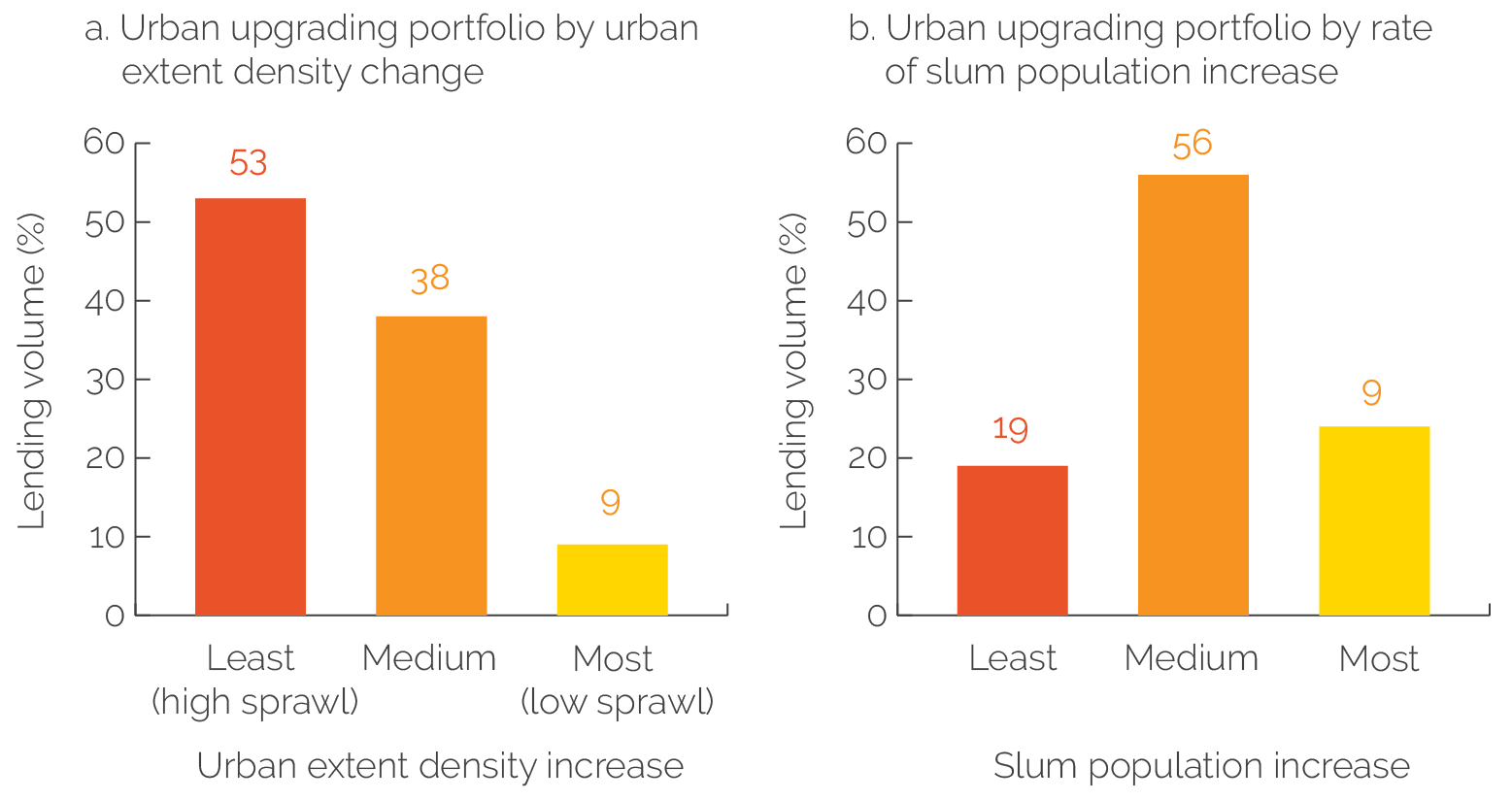
Sources: Independent Evaluation Group. Data on urban extent and urban population in 2000 and 2020 from Gao (2020a, 2020b). The analysis used “Proportion of Urban Population Living in Slums Time Period between 1990 and 2018” from the UN-HABITAT Urban Indicators database (https://urban-data-guo-un-habitat.hub.arcgis.com/).
Note: Density is measured in people per hectare.
Figure 2.4. Distribution of Land Administration Portfolio by Volume
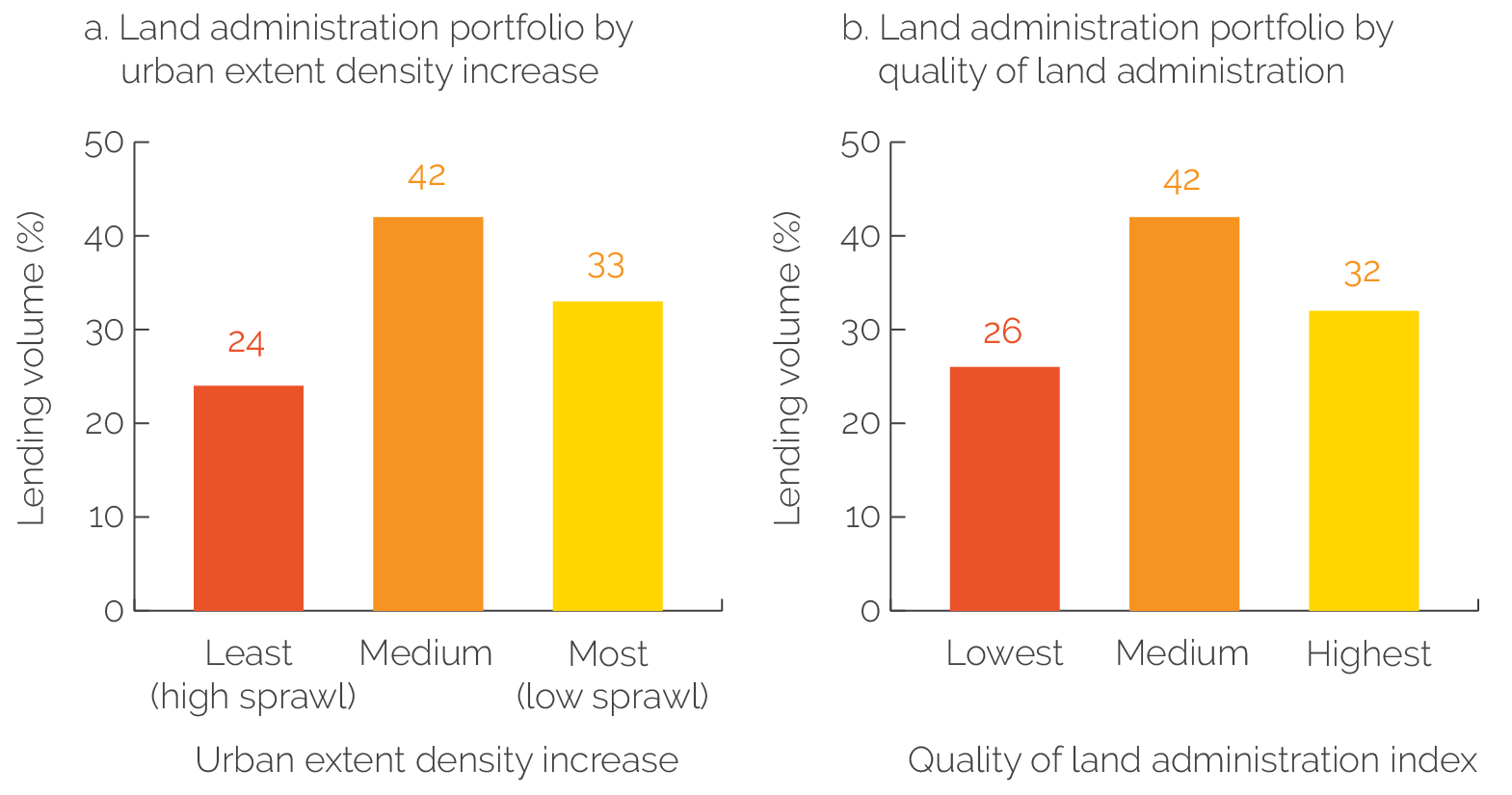
Sources: Independent Evaluation Group. Data on urban extent and urban population in 2000 and 2020 from Gao 2020a, 2020b. The analysis used the quality of land administration index from the Doing Business survey (2016–20).
Note: Density is measured in people per hectare.
To What Extent Is the Nature of World Bank Support Appropriate Given the Characteristics of the Challenge?
The World Bank has addressed urban expansion through preventive approaches to a limited extent. In 2013, the World Bank asserted that slums could be prevented through flexible land-use regulations and coordinated investments (World Bank 2013b). Preventive approaches are more cost-effective than curative approaches in addressing informal settlements and are necessary to address urban spatial growth in the periphery (Mehta and Dastur 2008). However, urban upgrading investments take place predominantly in largely built-up areas, which account for 92 percent of the focused urban upgrading portfolio. Only four projects (8 percent) supported the development of greenfield areas, which are primarily in the periphery. Support for preventive urban transport approaches is similarly lacking. Integrated land-use urban transport interventions support the formulation of land-use policies to strengthen land development and management. World Bank support to urban transport interventions instead focuses on improving accessibility and mobility. Only 11 percent of the focused portfolio goes to integrated land use. To address rapid urban expansion, it is necessary to deploy appropriate land-based tools that enable the orderly assembly of land to foster sustainable urban growth. Only 4 of 258 projects had land-based tools components. The low support for land-based tools is of concern because failure to meet the demand for urbanized land fosters the creation of slums. The limited use of these preventive approaches highlights the need for a framework that brings together different ways of addressing urban spatial growth in a coherent manner.
- Key reports contributing to the World Bank’s approaches to managing urban growth include Amirtahmasebi et al. (2016), Salat and Ollivier (2017), and Kaw, Lee, and Wahba (2020).
- From 1970 to 1999, Pristina had a population increase of 78.59 percent, and from 1999 to 2010, the city expanded by 175.37 percent (Gollopeni 2015).



